Here’s What You Need to Know About FICO Score 8
About Harrison
Harrison Pierce is a writer and a digital nomad, specializing in personal finance with a focus on credit cards. He is a graduate of the University of North Carolina at Chapel Hill with a major in sociology and is currently traveling the world.
Read full bio
At a Glance
FICO Score 8 is a credit score that lenders use to help determine a consumer’s overall credit risk. It is based on an individual’s payment history, amount of debt, length of credit history, new credit inquiries, and types of accounts they have. FICO Scores range from 300-850 points and are updated regularly based on an individual’s financial activities. A FICO Score 8 is the latest version of the widely used credit scoring system that uses factors such as past trends and economic conditions. In this article you’ll learn:
A FICO Score is a popular credit score that lenders use to help determine a consumer’s overall credit risk. It is based on an individual’s payment history, amount of debt, length of credit history, new credit inquiries, and types of accounts they have. FICO Scores range from 300-850 points and are updated regularly based on an individual’s financial activities.
Related: FICO score vs. Credit Score
What is FICO Score 8?
A FICO Score 8 is a credit score range developed by the Fair Isaac Corporation. It is used to evaluate consumer credit histories and assign numerical values to measure an individual’s financial profile. Financial institutions review FICO Score 8 when considering consumer loan applications, lease agreements, and insurance applications. FICO Score 8 works on a scale of 300-850, with higher numbers representing an individual with a strong payment history and good borrowing habits. Factors like payment history, debt utilization ratio, credit mix, and length of credit history all come into play while calculating the FICO Score 8.
FICO score 8 is the latest version of FICO’s classic scoring model, which lenders use to evaluate a person’s creditworthiness. The main difference between FICO 8 and its predecessor is that it considers risk factors more precisely with the help of performance-based analytics. Lenders rely on this new scoring model to make quicker and more reliable decisions, as it uses factors such as past trends, economic conditions, and personal payment histories more effectively than before. Moreover, FICO 8 also gives more weightage to accounts used responsibly in good standing than those rarely used or with higher balances. Considering this new model, people can improve their credit scores by using their credit cards responsibly and keeping their accounts up to date.
How does FICO Score 8 work?
A FICO Score 8 is important for understanding your creditworthiness and financial health. This three-digit figure is based on information from the major credit reporting bureaus and reflects the mathematical calculation of your overall credit issue record. Lenders use it to help determine whether to approve someone for a loan or a mortgage and assess how much interest they might be charged. The FICO Score 8 can range from 300 to 850, with anything over 700 usually considered good credit health. A higher score indicates greater risk, while lower scores represent a lesser risk level. Although everyone’s score will vary due to unique factors, several common underlying components are used when generating your score, such as payment history, amounts owed, length of credit history, new accounts opened, and types of debt – among other criteria. Knowing the specifics about your FICO Score 8 can help you understand where you fall and begin to make plans for improving it if you want to qualify for more favorable borrowing terms in the future.
1.How it’s calculated
This number is based on factors that make up your overall credit profile, such as payment history, amounts owed, length of credit history, and types of credit used. Each factor has its weight, and much emphasis is placed on recent actions, with older signals gradually losing their strength over time. This ensures that everyone’s FICO score is regularly updated to reflect their most recent financial behavior. These elements determine an individual’s ability to receive credit or access better borrowing terms. With a better understanding of how it’s calculated, you can be sure you are empowered to make the right decisions for your finances.
2.How it’s used
FICO score 8 is an essential tool used by lenders and other institutions to assess potential borrowers’ creditworthiness. It considers a person’s history of making payments, the amount of outstanding debt, and an overall look at their ability to manage credit over time. FICO score 8 also provides predictive analytics that can help lenders make more informed decisions regarding approving offers for credit cards, mortgages, and other types of loan products. This scoring model helps to ensure that both lenders and consumers benefit from accessing financial resources responsibly.
Understanding your FICO score 8 is essential when applying for loans or credit products. This score represents your creditworthiness. Keep in mind that lenders typically use this score to determine your interest rates, so monitoring your credit score is absolutely vital.
Achieve Your Credit Score Goals Effortlessly
Stay on track, get results, and keep learning with your personal credit score trainer
Stay on track, get results, and keep learning with your personal credit score trainer
How does FICO Score 8 differ from the scores you see on Credello?
There are actually several different credit scoring models available, each producing slightly different credit scores. For example, in addition to other versions of FICO scores, another popular credit scoring model is VantageScore. You may see different scores in different places, including on Credello, because while these models rely on similar factors, they may be graded slightly differently.
What affects your FICO 8 credit score?
Your FICO 8 credit score measures your overall creditworthiness and can vary from 300-850. The five factors that most of your FICO 8 score consists of are:
1. Payment history (35%): Your history of paying credit accounts on time (or missed payments).
2. Amounts owed (30%): How much you owe on credit accounts, including installment loans and credit cards, and the percentage of your available credit that you’re using (credit utilization rate).
3. Length of credit history (15%): How long you’ve had your oldest and newest accounts.
4. New credit accounts (10%): New credit inquiries (hard inquiries) and recently opened accounts.
5. Types of credit (10%): Mix of different credit accounts, such as credit cards, mortgage loans, auto loans, etc.
Specifically, your FICO 8 credit score can be greatly impacted by late payments, high debt levels relative to your income level or the number of open accounts and lines of credit, bankruptcies or collection accounts, or a low average age for all your credit accounts. You must understand these factors to fully comprehend how they will affect your FICO 8 Credit Score. Being mindful of these things helps you make more educated financial decisions so you can work toward keeping a high score.
FICO 8 Score ranges
Understanding the FICO 8 score range is important to good financial management. It measures your creditworthiness and determines how much lenders will give you. The latest version of this scoring system, FICO 8, has scores that range from 300-850. This number aggregates many variables, including payment history, length of credit history, new accounts, loan balances, and types of credit utilized. Experts suggest that 700 or higher is a good rating, while anything above 740 puts a borrower in an “excellent” category. A lower score does not necessarily indicate bad credit; it simply highlights areas for improvement for consumers who want to increase their chances of being approved for loans and other forms of credit products.
Related: Credit Score Ranges
FICO 8 vs. FICO 9 Score
When it comes to understanding credit scores, one of the most important distinctions is between FICO 8 and FICO 9 scores. FICO 8 was released in 2009, while FICO 9 came onto the consumer market in 2014. Major changes between these versions include improved explanations for “thin” credit files, more accurate predictions of user behavior, and greater consideration of medical collection accounts. As the latest version of FICO scoring technology, FICO 9 is often considered more predictive of future consumer debts and delinquencies than its predecessor. Understanding the differences between these two scoring systems can help potential loan applicants understand where their potential credit standings lie.
Related: What Does FICO Score 9 Mean
FICO 8 vs. other FICO Scores
FICO 8 is a credit scoring model that’s used widely by lenders. It considers millions of data points to generate a score, allowing lenders to make more informed decisions. FICO 8 is just one part of the larger FICO family of scores, and every type of score plays an important role in helping lenders determine how likely you are to repay debts and manage credit responsibly. It’s worth noting, however, that FICO 8 scores aren’t used in all situations; for instance, different scores may be used for auto loans or mortgages. Ultimately, each lender decides which scoring model they’ll use based on the individual circumstances controlling whatever loan or credit product is offered.
FAQs
A FICO 8 Score and a credit score are two different measures of a consumer’s creditworthiness. A FICO 8 Score is the most used type of credit score, developed by Fair Isaac Corporation (FICO) in 2008, and is modeled after previous models such as FICO 5. The main difference between a FICO 8 Score and other credit scores regards specific categories that are evaluated. In contrast, a FICO 8 Score considers more than 20 elements, including the number of inquiries, types of credits held, payment history on accounts, and collections activity; other credit scores might focus on different components and use alternative formulas to determine consumer risk levels. Therefore, consumers should always be aware of the model used for their credit reports before interpreting the result.
Learn more: FICO Score vs. Credit Score
A FICO 8 Score is the credit score used in the U.S. It is based on a range of 300-850, with 850 being the highest possible rating and 300 being the lowest. The average FICO 8 Score measures around 700, with anything above 750 considered excellent and anything below 600 considered poor. Different factors, such as repayment history and amount of debt, are considered when calculating an individual’s FICO 8 Score. Knowing one’s current credit rating can help to understand how lenders may judge potential applications for products such as loans or credit cards.
Learn more: What is an Average Credit Score
Banks look to your FICO Score 8 when determining the terms and conditions of a loan. These scores gauge your reliability and reflect that on their services, as they want to offer loans to those who are likely to pay them back on time. Through research, lenders have found that your FICO Score 8 offers insight into your likelihood of making timely payments, a key factor in their decision-making process. FICO Score 8s also factor in how much debt you already have and where it stands with each bank account or credit facility, helping banks assess your overall financial health before extending any loan. So, while a single FICO score may not be the ultimate determiner of whether you receive a loan, it certainly plays an influential role in the decision-making process at banks.
FICO score 8 is the most widely used credit score in the U.S. and is accepted by most lenders. It was introduced in 2006 and was the first FICO score model to replace the previous FICO score systems. While it is mostly used for mortgage applications and auto loans, some personal loan providers also accept FICO Score 8. Ultimately, your acceptance for a personal loan will depend on your creditworthiness but having a good FICO Score 8 could go in your favor when applying.










